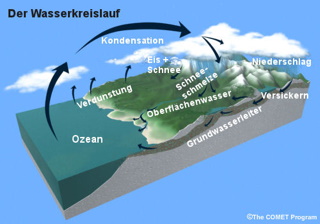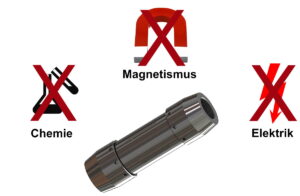Water dictionary
Interesting facts about water.
Why does a limescale deposit occur?
The "lime" dissolved in water settles in the pipes and fittings. During heating, the limescale deposits on the heat-transferring elements (heating walls, kettle, washing machine, etc. ...)
What is the water hardness?
To understand this, we have to take a look at the water cycle. About 70% of the earth's surface is covered with water. This water evaporates in sunlight and water vapour is formed. This is lighter than air, therefore rises upwards and collects in the atmosphere.
If the water drops are large enough, they fall back to the earth in the form of rain, snow or hail.
The carbonated water seeps into the soil and hits calcareous rock under the surface.
The carbonic acid and lime react to form calcium hydrogen carbonate (Ca(HCO³)², colloquially lime).
Around 75%

Around 75% of all households in Germany have calcareous water.
1° dH corresponds to 1.78 g per 100l water vapour. With an average of 150 cbm of water in the household, about 50kg of lime are introduced into the house installation per year.
Due to the heating of the water, about 15 kg of "lime" per person remains in the piping system. This creates a "limescale" deposit on the heat-transsiting elements and the following situation results.
1mm limescale leads to 10% more energy expenditure. (see graphic)
PeterAqua FR Water treatment
As the water flows through our FR, it absorbs information that strengthens the lime-carbonic acid balance. As a result, the "limescale" is not only flushed out as the water flows through, but also takes existing limescale with it.
Scale protection
Our technology ensures that the solid lime components of the water remain in solution in piping systems and are not deposited. Thanks to the high efficiency, existing deposits are also broken down.
Minor or prevented deposits  means a lower energy expenditure and thus lower costs.
means a lower energy expenditure and thus lower costs.
The advantageous price, the simple installation (both in new and old buildings) and the reduction of operating costs ensure the rapid amortisation of our technology.
The efficiency and quality of our technology has been proven in numerous tests in various large and small systems.
Healthcare
Calcium is one of the most important minerals that humans need for a healthy organism. It cannot be produced in the body itself. The body of an adult contains on average about one kilogram of calcium, 99 percent of which is stored in bones and teeth. A long-term calcium deficiency can lead to considerable health damage. In particular, the disease of osteoporosis - popularly called bone loss - can result in a chronic undersupply of calcium. Without a sufficient calcium intake, muscle cramps, high blood pressure, caries and periodontal disease, as well as increased excitability of the nervous system, can occur.
The daily requirement of an adult is 1000 milligrams of calcium per day. Children and adolescents even have an even higher need.
Drinking tap water is not enough to meet the daily requirement of calcium. Rather, a combination of different foods is necessary for this. However, calcium-rich drinking water can have a supportive effect and at the same time give the water more flavour. Currently, the Drinking Water Ordinance does not prescribe a limit value for calcium.
Water treatment possibilities (further info from Hans)
PeterAqua FR Water treatment
As the water flows through our FR, it absorbs information that strengthens the lime-carbonic acid balance. As a result, the "limescale" is not only flushed out as the water flows through, but also takes existing limescale with it.
Scale protection
Our technology ensures that the solid lime components of the water remain in solution in piping systems and are not deposited. Thanks to the high efficiency, existing deposits are also broken down.
Minor or prevented deposits  means a lower energy expenditure and thus lower costs.
means a lower energy expenditure and thus lower costs.
The advantageous price, the simple installation (both in new and old buildings) and the reduction of operating costs ensure the rapid amortisation of our technology.
The efficiency and quality of our technology has been proven in numerous tests in various large and small systems.
Healthcare
Calcium is one of the most important minerals that humans need for a healthy organism. It cannot be produced in the body itself. The body of an adult contains on average about one kilogram of calcium, 99 percent of which is stored in bones and teeth. A long-term calcium deficiency can lead to considerable health damage. In particular, the disease of osteoporosis - popularly called bone loss - can result in a chronic undersupply of calcium. Without a sufficient calcium intake, muscle cramps, high blood pressure, caries and periodontal disease, as well as increased excitability of the nervous system, can occur.
The daily requirement of an adult is 1000 milligrams of calcium per day. Children and adolescents even have an even higher need.
Drinking tap water is not enough to meet the daily requirement of calcium. Rather, a combination of different foods is necessary for this. However, calcium-rich drinking water can have a supportive effect and at the same time give the water more flavour. Currently, the Drinking Water Ordinance does not prescribe a limit value for calcium.
Water treatment possibilities (further info from Hans)
Physical water softening
- This term includes processes that are intended to change the structure of lime crystals by means of electric or magnetic fields in such a way that a deposit on pipes is reduced. Here, e.g. B. Magnets or current-carrying wires attached to the outside of water pipes or plates controlled with alternating voltage inside the flow-through device directly into the path of the water. Some devices are still equipped with a "pre-filter", which in reality is a small Ion exchanger is.
- The Foundation Warest Published in January 2000 an investigation of such water treatment devices. In most cases, no effect could be detected; only the three devices with filter cartridges to be changed regularly showed a significant reduction in limescale deposits in electric boilers.[ 1] The result of an earlier test by Stiftung Warentest[2] was thus confirmed.
- A plausible hypothesis for the effectiveness of such methods does not exist, and published "scientific" experiments on effectiveness are not reproducible.[ 3] This includes one of the Swiss Federal Office for the Environment, Forestry and Landscape Commissioned study as part of a dissertation.[ 4][5]
Mehr lesen… (Verweis auf Sub-Seite zwecks SEO)
Further procedures
- Entfernung der temporären Härte (Carbonathärte) By boiling the water. It forms in the process Kesselstein. In the water remains the Permanent water hardness Back. This process is under Water hardness described in more detail.[ 6]
- Falling by adding a suspension of Calciumhydroxid (Lime milk); the formed Calciumcarbonat will be at the Long-term decarbonisation as mud and at the fast decarbonisation as so-called Heart grain cancelled. The process only leads to the removal of the carbonate hardness.
- One of the oldest methods for extensive softening is the Lime–Soda-Procedure. With this, already in the 19th The process developed in the 19th century can reduce the total hardness to less than 2.0 °dH (approx. 1.1 °fH) be reduced. Calcium and magnesium are preferred as Dolomit liked. The water is heated to accelerate the precipitation reaction. However, the addition of soda increases the sodium content of the water. This process was important for the production of low-hardness water for the operation of steam engines and steam locomotives. Due to the development and introduction of ion exchangers for softening, the process lost its importance and is no longer used today.
- Internal cooking water treatment Z. B. at Steam locomotives.
Mehr lesen… (Verweis auf Sub-Seite zwecks SEO)
The Chemische Wasseraufbereitung - Wasserendhärtung durch Ionenaustausch
lore ipsum
Mehr lesen… (Verweis auf Sub-Seite zwecks SEO)
Die Physikalische = Einsatz elektrischer Felder – z. B. zur Elektrolyse – kombiniert mit Kartuschen bzw. Austausch-Granulat-Behälter.
lore ipsum
Mehr lesen… (Verweis auf Sub-Seite zwecks SEO)
Die Magnetische = Einsatz von je 1 der 3 Magnet-Felder: Dauer-, Elektro-, Induktivmagnet
lore ipsum
Mehr lesen… (Verweis auf Sub-Seite zwecks SEO)
Die Biokatalytische - Granulat mit dem Ferment beschichtet, das den Kalk kristallisiert.
lore ipsum
Mehr lesen… (Verweis auf Sub-Seite zwecks SEO)
PeterAqua FR Water treatment
Über die Oberfläche unserer Glaszylinder nimmt das Wasser beim vorbeifließen Informationen auf, die das Kalk-Kohlensäure Gleichgewicht festigen. Dadurch wird der „Kalk“ nicht nur ausgeschwemmt, sondern nimmt auch vorhandenen Kalk mit.
CHINESISCHE ANSAMMLUNG WIRD NOCH AUSFORMULIERT........... Traditional physical and chemical water treatment
Pollution
- The devices require electricity and thus generate energy consumption
Use of chemicals - Limited avoidance of corrosion
- High operating and maintenance costs
- Discharge (sodium ions/potassium ions) does not correspond to the norm
- The external world is influenced by the use
- Personnel operation and maintenance require high and comprehensive operating costs
FR water treatment
- Energy savings of up to 30%
- Extending the service life of the equipment by at least 50%
- Save water, electricity and gas (for heat generation)
- No operating and maintenance costs
- No emission costs
- High standard of environmental protection
- How to reduce the safety risk of company production
